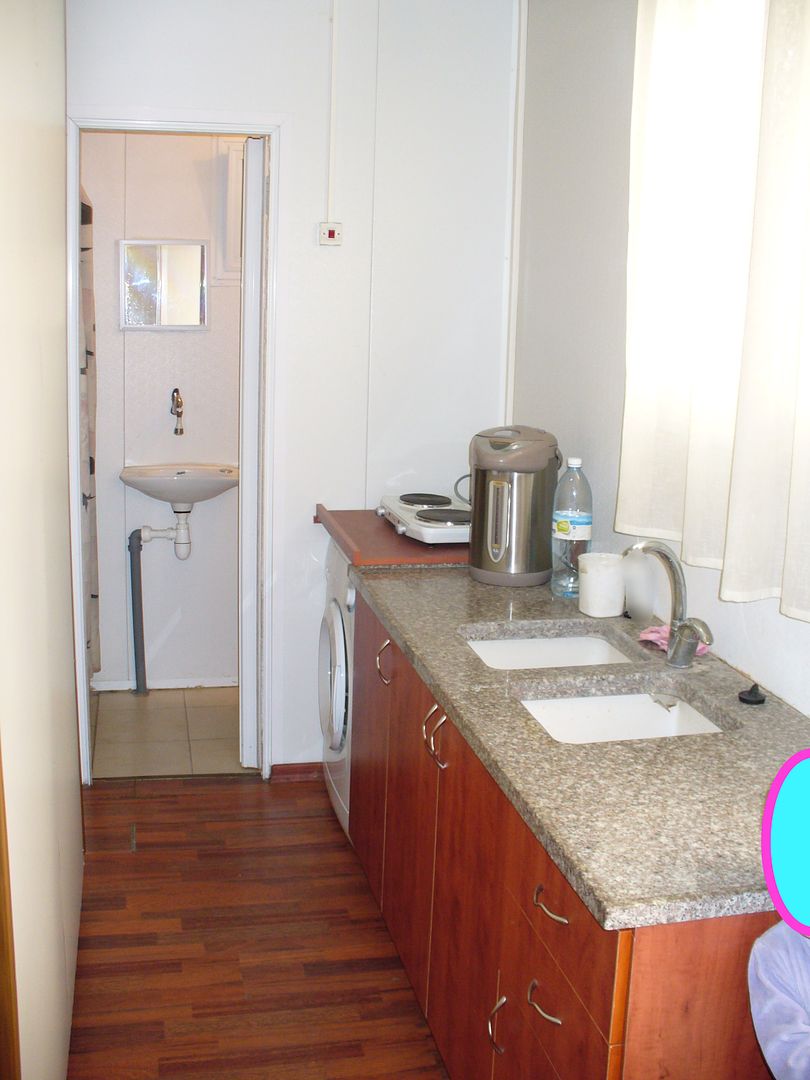 |
| Cara’s tiny kitchen/laundry room before her husband built more shelves to make it more space efficient |
You might remember when I posted about when I visited a friend who lived in an even tinier house than mine? That friend, Cara, shared this lovely guest post with her reasons behind living in a tiny house, and how she and her husband make it work. Though most people don’t live in a house as small as hers, and wouldn’t even consider it, these tips are worthwhile for anyone who is interested in downsizing their home, and how to make the best use of less space.
My husband and I have been married for two years and three months. We’ve never lived in a big house—nor do we want to, for a variety of reasons.
First of all, we are both slightly nervous in wide-open spaces and prefer the comfort of walls around us. Kind of the opposite of claustrophobia, although I wouldn’t say it’s even that bad. Also, I’m a terrible housewife, so the less space I have to clean, the better.
Our first apartment—which was in the suburbs, actually in the same little town where Penny’s husband grew up—was 183 square feet. One bedroom and a tiny little kitchenette that I could barely find space to cook in. It was a basement apartment with only one window and barely any furnishing. Naturally, guests were out of the question—we managed to squeeze a girlfriend of mine in for dinner once and another time my sister came over for lunch, but that was all.
Fortunately, we moved out of there and back into the city around six months later. Our second—and current—apartment is 225 square feet. It feels like a palace compared to our old place. The rent nearly doubled, unfortunately, from 340 dollars to 565 dollars, but we nearly made up with that what with not having to take the 3-dollar-each-way bus into the city for work every day. From here, my husband is able to bike everywhere (see this guest post Cara wrote about their uber cool bike) and I’m able to walk most places, so our transportation costs are nearly zero. And now we are not so isolated out of town, and can even have guests, including the Penniless family. (Having guests over for meals is a big part of our culture; people are much more likely to invite their friends over for dinner than to get together outside for a movie or whatever.)
We are happy living in the city, despite the increase in price, and plan to stay here long-term. I’m American, living in a country where I don’t speak the native language very well, so jobs are limited. In our tiny place in the suburbs, I was always on the run (or more accurately, the bus), from this to that to the other low-paying part-time job, usually babysitting. Right now, that’s not an option—for medical reasons I need to be in the city and I also need a flexible schedule, ideally working from home—which means it is essential that we live in the smallest, cheapest apartment we can find.
-Use the space on the walls! I can’t stress this enough. Many if not most places come with a bunch of space that is never ever used— the walls and ceiling. When we were in our first tiny apartment my husband screwed hooks into the ceiling and tied our suitcases up there, and built a bunch of shelves on the wall. In our current place, he’s built a bedside shelf where I keep my glasses and alarm clock and such.
We also have very few kitchen cupboards, so he built some shelves above our sink. They contain most of our dishes as well as sugar, salt, tea, and the like.
He’s planning to build some shelves above the refrigerator, but meanwhile we use it for space too by just putting things on top of our refrigerator. Currently we have up there a vase of flowers, a huge bag of rice, a bunch of canned food, and a bag of flour.
And since most apartments around here come without any built-in closets, he built his own just before we got married.
-Our wall is literally made of bookshelves, floor-to-ceiling, and we fill them with our hundreds of books, but in general I wouldn’t recommend following our example, since you wouldn’t have a place to put them in most tiny houses. Buy a Kindle instead and keep all your books in one place.
-You really, really don’t need a dryer. We wouldn’t know where to put ours. A clothes rack is sufficient.
-Since a tiny house can feel claustrophobic sometimes, I really highly recommend that you only move into one that has windows. This has the added benefit of lots of natural light—these days I save on electricity and most of the time, even though I’m generally home all day, I don’t even turn on a light until 6:30 pm or later.
-In a kitchen with limited pantry space, you’ll want to cook from scratch as much as possible, as processed food takes up space. A 2-pound bag of rice, for example, probably takes up about the same amount of space as one TV dinner, but the rice could be the base of a week’s worth of meals for a whole family.
We don’t have children yet, and probably won’t be having any for another year or more, so I concede that some of these ideas are much easier to implement when there are only adults living together. That said, when my husband found out I was writing this, he told me that I should mention bunk beds—not the standard two-bed ones, but we’ve both seen them stacked 3 or 4 beds high. He actually considered building bunk beds for us but I put my foot down and told him there was a limit to frugality and saving space!
And I just want to mention, a week or so after I first wrote this, that we just signed a contract and will be moving to another apartment. It’s slightly more expensive; it’s 700 dollars, unfortunately, but 270 square feet with a lot more wall area to build shelves on, storage space outside the apartment, and a porch and available ground outside for a garden! I’m excited.
I hope some of these ideas are helpful to anyone thinking of tiny house living.
How large is your home? Would you call your home large, medium, small, tiny, or something else? What tips would you add to make “smaller home living” work for you, whether your house is as tiny as Cara’s or mine, or even larger, but still smaller than average?
Linking up to Frugal Days, Sustainable Ways




